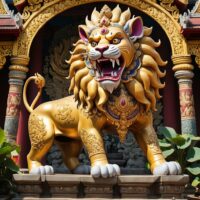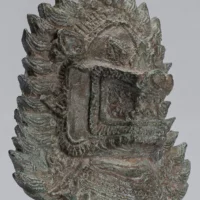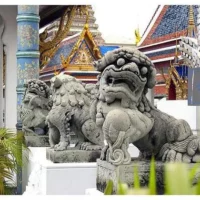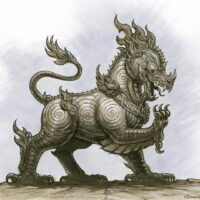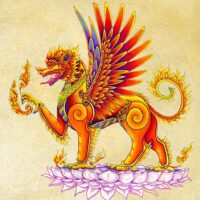Singha : The Guardian Lion
Listen
At a glance
| Description | |
|---|---|
| Origin | Thai Mythology |
| Classification | Hybrids |
| Family Members | N/A |
| Region | Thailand |
| Associated With | Protection |
Singha
Introduction
Singha, also known as Singh in Thai mythology, is a mythical creature revered for its significance as one of Buddha’s protectors. Resembling a lion with majestic wings, Singha holds a prominent place in Thai culture, influencing values, traditions, and artistic expressions. This majestic creature embodies strength, courage, and unwavering loyalty, symbolizing royalty and nobility within Thai folklore. Singha’s enduring presence reflects its historical and modern relevance in shaping Thai society and cultural heritage.
Physical Traits
The Singha, resembling its real-world counterpart, possesses a powerful build, flowing mane, and fierce gaze characteristic of lions. However, in Thai artistic traditions, the Singha is elevated beyond the ordinary. Depictions often showcase an ornately decorated mane adorned with jewels or flames, while its tail may curl or split, symbolizing its otherworldly nature. Unlike regular lions, the Singha can stand on its hind legs, emphasizing its regal bearing. Some interpretations even grant the Singha wings, blurring the lines between the terrestrial and the celestial.
In Thai mythology, the Singha is portrayed as a unique amalgamation—a half-man, half-lion figure with a lion’s head, tusks, and mane, coupled with the body of a human warrior. This fusion of traits embodies power and ferocity. Often depicted guarding temple entrances or perched atop gateposts, the Singha’s presence is significant in Thai religious and architectural symbolism. For example, the marble temple of Wat Benchamabophit in Bangkok features numerous large Singha figures gracing its compound.
The mythical Singha combines leonine attributes with avian features, such as majestic wings sprouting from its back. Its body, covered in regal golden fur that shimmers in sunlight, exudes authority and power. This unique depiction allows the Singha to soar through the skies with grace and majesty, distinguishing it from ordinary lions in Thai mythology.
Family
The Singha’s origins are veiled in mystery, lacking a definitive origin story. According to some beliefs, it is the offspring of a lion and a celestial being, while others suggest it rules over a pride of similar creatures in the mythical Himmapan Forest—an imagined Himalayan paradise teeming with fantastical beings. The Singha is often paired with the Kinnari, a celestial maiden possessing the head and torso of a woman and the lower body of a bird. This union symbolizes the combination of strength with beauty, vigilance with grace. In certain depictions, the Kinnari rides atop the Singha, highlighting the symbiotic relationship between them.
A less common yet intriguing variation is the Apsonsi, a hybrid creature blending the fierceness of the Singha with the allure of an Apsara, a celestial nymph. Revered as guardians, both the Apsonsi and Singha hold significance, particularly at Wat Phra Kaew (The Emerald Buddha Temple) in Bangkok.
While explicit details about the Singha’s family lineage are scarce in Thai mythology, it is part of a larger pantheon of mythical creatures inhabiting the Thai spiritual world. This pantheon includes various local spirits and deities associated with protecting specific places, villages, or activities, often tied to natural elements such as rivers and trees. Singha, regarded as a symbol of nobility and greatness, is considered a divine being associated with royalty and often depicted as a guardian or protector of important figures, including gods and kings, highlighting its mystical lineage within Thai folklore.
Other names
The Singha’s influence transcends a single name, manifesting through a spectrum of titles across Thailand, each highlighting a specific facet of its nature. One such title is “Rajasiha,” which translates to “king of lions,” underscoring the Singha’s role as a powerful ruler and protector within Thai mythology. Another significant name is “Thep,” signifying divinity and elevating the Singha beyond a mere beast to a celestial being revered for its supernatural attributes. Additionally, the term “Himmapan Lion” references the Singha’s mythical habitat, the Himmapan Forest, further enriching its lore and connection to the mystical realms.
The name “Singha” itself finds its roots in the Hindu word “Singh,” derived from the Sanskrit “Simha,” meaning lion. This name underscores the Singha’s leonine characteristics and its association with strength and courage. Throughout Thai culture, the Singha is recognized by various names reflective of local folklore and regional variations of Thai mythology, which emphasize its enduring presence across diverse cultural narratives. Each name contributes to a nuanced understanding of the Singha’s multifaceted nature, showcasing its significance as both a symbolic guardian and a divine entity within Thai spiritual beliefs.
In Thai astrology, the Singha can also be seen in alignment with the zodiac sign of Leo, further reinforcing its celestial connections and significance in cosmic interpretations. The silent final syllable in “Singha” adds a mystical touch to its pronunciation, echoing the enigmatic essence of this mythical creature. Across different contexts and regions, the Singha’s alternative names continue to evoke its regal presence and mythological significance, demonstrating its lasting impact on Thai culture and identity.
Powers and Abilities
The Singha’s role as a defensive guardian in Thai mythology extends beyond physical strength to encompass profound symbolic significance. In Buddhism, the Singha is frequently depicted as a protector of dharma, embodying the law of righteousness and safeguarding temple sites and thrones of statesmen. Its presence signifies not only physical protection but also spiritual guardianship, warding off evil spirits and ensuring prosperity for those under its watch. The Singha’s abilities symbolize leadership, bravery, and power, reflecting cherished qualities among the Thai people and associating the creature closely with notions of royalty and divinity.
Central to the Singha’s identity are its formidable abilities, which reinforce its status as a revered protector within Thai folklore. Possessing superhuman strength, the Singha is believed capable of extraordinary feats, defending against any threat that may arise. This mythical creature’s role goes beyond mere physical defense; it embodies mystical guardianship, often depicted standing watch over temples and palaces to safeguard these sacred sites. Additionally, the Singha serves as a potent symbol of royalty in Thai culture, its regal bearing and unwavering loyalty aligning it with the monarchy’s ideals of strength and authority.
Ancient texts linking the Singha to the sun establish a profound solar connection that imbues the creature with divine power and illumination. This celestial association underscores the Singha’s transcendence beyond earthly realms, positioning it as a symbol of enlightenment and spiritual protection. Through its solar connection and supernatural attributes, the Singha embodies the ideals of prosperity, bravery, and fortune, making it a revered icon in Thai mythology and culture.
Modern Day Influence
The Singha’s influence is palpable in modern Thailand, manifesting as a potent symbol across various facets of society. As a national emblem, the Singha symbolizes strength and resilience, prominently featured on official insignia and flags, embodying its role as a guardian and protector deeply rooted in Thai heritage. Statues of Singha continue to adorn the entrances of temples and palaces, serving as architectural guardians that protect sacred spaces and uphold cultural traditions.
In the realm of commerce, the Singha name and image are integral to Thai branding, notably represented by the popular Singha beer brand. This commercial association extends beyond mere marketing, evoking positive connotations of strength, celebration, and national pride among consumers. Additionally, the Singha remains a wellspring of artistic inspiration for Thai artisans, influencing traditional and contemporary art forms. Its majestic presence adorns murals, jewelry, and various everyday objects, serving as a tangible expression of cultural identity and enduring mythological significance.
The legacy of the Singha extends beyond folklore into the fabric of modern Thai society, resonating through the Singha Corporation—a renowned Thai beverage company that derives its name and logo from this mythical creature. This integration of symbolism underscores qualities of quality, tradition, and national identity, fostering a sense of pride and connection among the Thai populace. Furthermore, the Singha’s portrayal in popular media, including films, literature, and festivals, continues to captivate audiences and ensure its enduring presence in the collective imagination of the Thai people. Through these diverse manifestations, the Singha remains a powerful cultural icon, bridging ancient mythology with contemporary expressions of Thai culture and identity.
Related Images
Frequently Asked Questions
What is lorem Ipsum?
I am text block. Click edit button to change this text. Lorem ipsum dolor sit amet, consectetur adipiscing elit. Ut elit tellus, luctus nec ullamcorper mattis, pulvinar dapibus leo.
What is lorem Ipsum?
I am text block. Click edit button to change this text. Lorem ipsum dolor sit amet, consectetur adipiscing elit. Ut elit tellus, luctus nec ullamcorper mattis, pulvinar dapibus leo.
What is lorem Ipsum?
I am text block. Click edit button to change this text. Lorem ipsum dolor sit amet, consectetur adipiscing elit. Ut elit tellus, luctus nec ullamcorper mattis, pulvinar dapibus leo.
What is lorem Ipsum?
I am text block. Click edit button to change this text. Lorem ipsum dolor sit amet, consectetur adipiscing elit. Ut elit tellus, luctus nec ullamcorper mattis, pulvinar dapibus leo.
What is lorem Ipsum?
I am text block. Click edit button to change this text. Lorem ipsum dolor sit amet, consectetur adipiscing elit. Ut elit tellus, luctus nec ullamcorper mattis, pulvinar dapibus leo.

